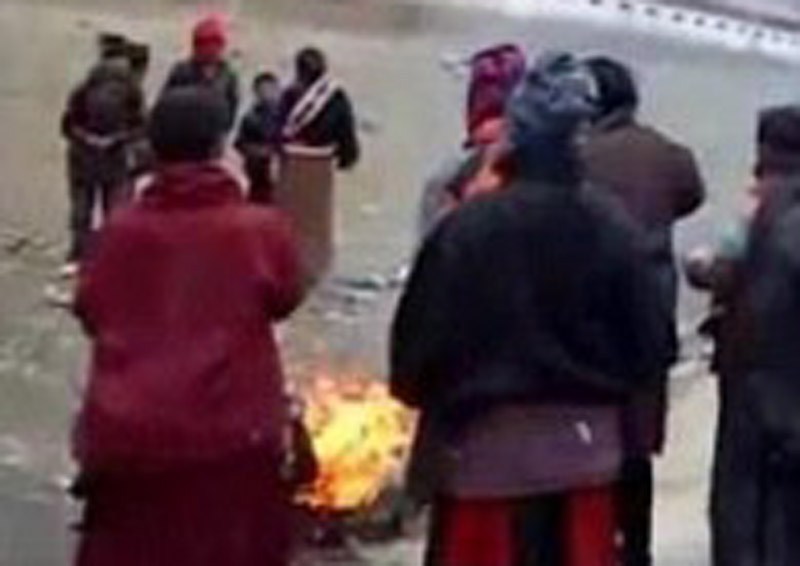 Dharamsala, May 31st, 2012: Tibet Women's Association (TWA) grieves the death of Rikyo (aged 36), mother of three children who died after setting herself alight outside the Jonang Dzamthang monastery in the town of Barma, in Dzamthang in Amdo Ngaba on May 30. It marks the 6thth case since 2009 and 25th since January 2012.
Dharamsala, May 31st, 2012: Tibet Women's Association (TWA) grieves the death of Rikyo (aged 36), mother of three children who died after setting herself alight outside the Jonang Dzamthang monastery in the town of Barma, in Dzamthang in Amdo Ngaba on May 30. It marks the 6thth case since 2009 and 25th since January 2012.
11 people have survived these self immolations, but TWA is unable to gather information about their whereabouts as Chinese authorities have kept this information to themselves denying families visitation rights.
On October 17th, 2011 nun Tenzin Wangmo (20) from Dechen Chokorling near Ngaba town called for religious freedom in Tibet and the return on the Dalai Lama as she set herself on fire and died outside of the nunnery.
On November 3rd, 2011, in Tawu, Kardze, 35-year-old Palden Choetso of Gaden Choeling Nunnery died after she self-immolated and shouted "Tibetans will reunite soon" and "long life for His Holiness the Dalai Lama," and called for basic human rights in Tibet.
On February 11th of this year, a nun from Dechen Chokorling,Tenzin Choedron (18), died after setting her body on fire near the nunnery while shouting slogans of protest against the Chinese government.
On March 3rd this year, Tsering Kyi, a student from the Tibetan middle School in Machu, set herself ablaze at the vegetable market in Tro Kho Menma Shang village in Machu.
On March 4th this year, Richen, a widowed mother of 4 children from Ngaba, died after setting herself alight in front of a Chinese police surveillance station at the main gate of the Kirti monastery and calling for the return of His Holiness the Dalai Lama and freedom in Tibet.
Rikyo, a nomad by profession is survived by her husband and three children. TWA pays tribute to her sacrifice and deem her act as the ultimate form of non-violent protest.
All of them called for freedom inside Tibet and for the return of His Holiness the Dalai Lama to Tibet.
In recent months both the geographical spread and scale of Tibetan unrest has grown, with self-immolations now encompassing the Tibetan areas of Sichuan and Qinghai and the Tibet Autonomous Region. Several protests have ended with Chinese police forces openly firing at demonstrators-the extrajudicial murder of innocent Tibetans.
In April this year, TWA launched a report titled *'A Study of Tibetan Self Immolations: Its history, motive and reaction.' *The report provides a brief summary of the 34 self-immolations that took place between February 27th, 2009 and March 30th, 2012 and an overview of the international response to these acts of self-sacrifice. It also provides a perspective on the new heightened form of non-violent protests inside Tibet which continue to alarm the world.
TWA requests global intervention to save Tibetan lives:" we ask world governments to apply multilateral pressure and take action against China to end the crackdown and allow free press inside Tibet. We call on the honorable Navanethem Pillay, United Nations High Commissioner for Human Rights, to visit the troubled areas in Tibet and assess the situation with a fact-finding mission."
The subsequent self immolations this past week since March 27th comes few days ahead of the 23rd anniversary of the June 4th Tiananmen square massacre that killed thousands of democracy activists mostly students. The spate of self immolations inside Tibet and the growing dissent amongst the Chinese people indicate the failed policies of the repressive Chinese Communist Party.
TWA urges the new Chinese leadership who is scheduled to take over early next year, to review the existing hard-line policies of the Chinese government and pave way for the immediate restoration of peace and freedom inside Tibet through dialogue with the Tibetan leadership in exile.


![Tibet has a rich history as a sovereign nation until the 1950s when it was invaded by China. [Photo: File]](/images/stories/Pics-2024/March/Tibet-Nation-1940s.jpg#joomlaImage://local-images/stories/Pics-2024/March/Tibet-Nation-1940s.jpg?width=1489&height=878)















